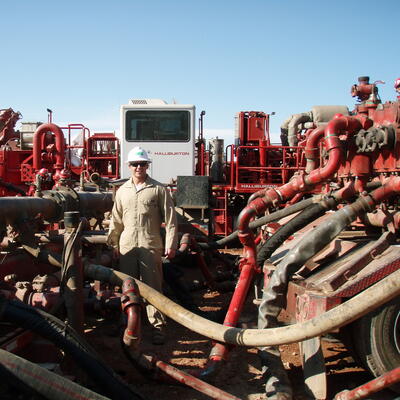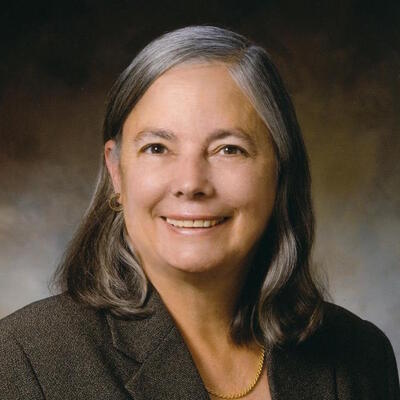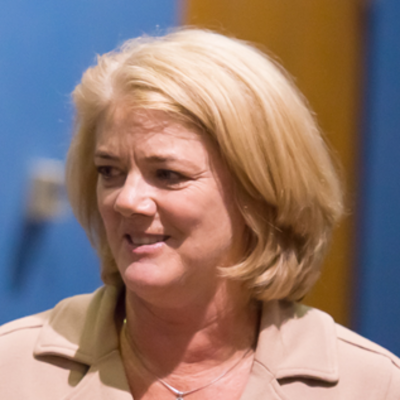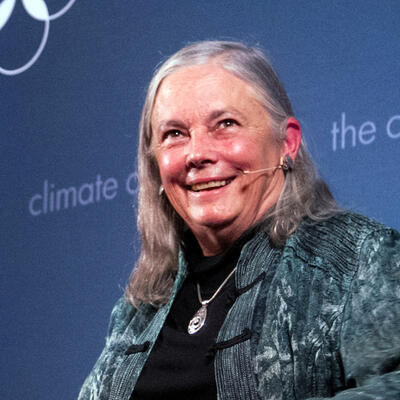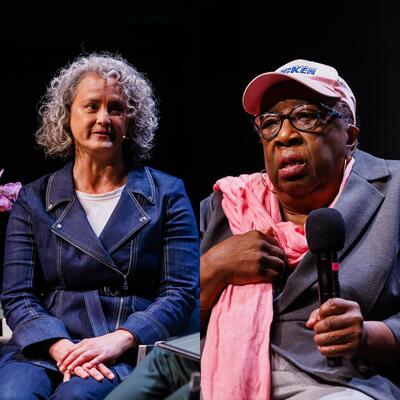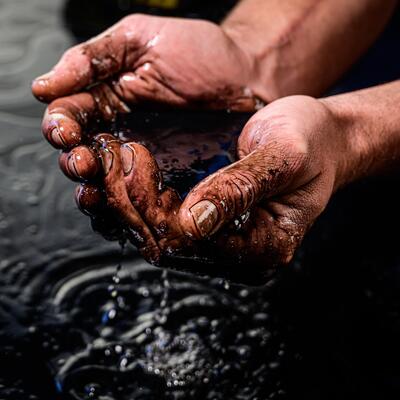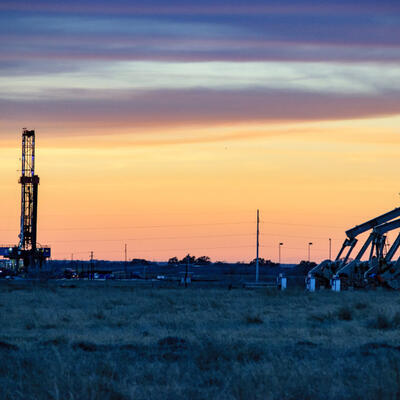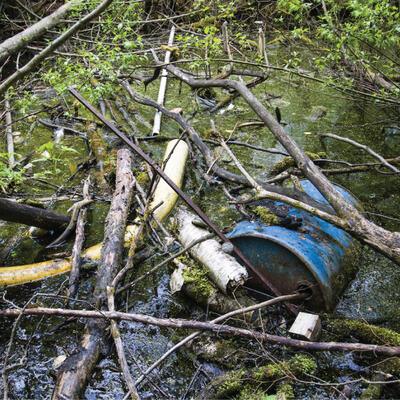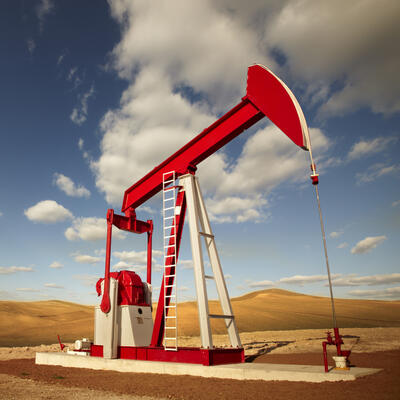Greg Dalton: I’m Greg Dalton and today on Climate One we will discuss powering California’s economy. Governor Jerry Brown recently signed a law that for the first time regulates hydraulic fracturing or fracking in the state. Fracking involves injecting water, sand and chemicals into underground rocks to release fossil fuels. These often associate with natural gas but for years companies in California had been using it in oil wells.
Recent advances in technology make it feasible to economically extract oil bubbles trapped in shale rock along the coast and in the Central Valley. And as a result, California could be on the verge of an oil boom. And the new fracking law lays down the rules for how that could play out. At the same time, California is forging ahead with programs to reduce carbon pollution that is driving severe weather.
The state has linked arms with Oregon, Washington and British Columbia in an alliance to promote clean energy and combat climate disruption. Can California be a climate leader and increases production of fossil fuels? Over the next hour, we’ll talk about that and California’s energy future and include questions from our live audience here at the Commonwealth Club in San Francisco.
We’re pleased to have with us three people deeply involved in the state’s energy debate.
Paul Deiro is an energy lobbyist for the Western States Petroleum Association with KP Public Affairs. Ann Notthoff is California Advocacy Director at the Natural Resources Defense Council and
Fran Pavley is a State Senator and author of the new fracking law. Please welcome them to Climate One.
[Applause]
Senator Pavley, let’s begin with you. Tell us what this new fracking law does for California.
Fran Pavley: Well, a year ago at this time we really didn’t know much about fracking frankly. And I had a couple of hearings, we didn’t know which wells were being fracked, what chemicals were being used, where they stored the wastewater. The ability to notify adjacent property owners wasn’t available, so there were a lot of things we didn’t know. And so the purpose of SB 4 is to create transparency and accountability, so Californians would know a lot more about fracking.
And we did it by also tying in our State Water Board and our Air Resources Board who could do some of the hard work on the ground and monitoring ground water, potential ground water pollution as well as air pollution, methane and other VOCs and other things. So an important work to be done because we hadn’t as a state been regulating fracking other than the fractural integrity of the well casing.
Greg Dalton: And you have written some of the most important environmental legislation in this country in the last 10 years. Tailpipe emission rules became a national model, California’s Climate Law signed by Governor Schwarzenegger to put in place, Cap and Trade, one of the only prices on carbon pollution in the world, and now this. And yet, environmentalists are mad at you saying that you caved and sold out to big oil. Your response.
Fran Pavley: Well, both these people up here on the stage with me probably could deny that, as well as myself. It was a problem that had to be solved, and without the transparency for Californians to figure out what was going on with fracking, that created an area that I thought I should intersect myself with. You know, California, we drive 40 million cars, in California.
Unfortunately, despite a lot of good work — and in fact this year, Greg, we passed two bills that really are quite exciting. One bill was to expand in the next 10 years, $2 billion to incentivize the purchase of alternative fuel vehicles and engage in research and development for cleaner transportation fuels. Last week, I think the governor announced the eight-state pact with other states working with California to put on the road $3.3 million EVs. I mean, that’s amazing work, and so we’re trying to balance that. We’re a state that needs to reduce our fuel consumption, move to alternative fuel vehicles.
We also need to understand that there’s a transition period, and here we are faced with the Monterey Shale formation with all these oil, with the unknown facts as far as state agency regulations, is fracking can be safe or not. And what I’m trying to do is put a public face on this, as far as making sure the public has all the factual information. If they decide it’s unsafe, you’ll see the public change and demand and do something else and nothing in as before prevents local governments from adapting their own regulations from the governor, looking at the moratorium or more stringent regulations or handcuffs the legislator from doing more. So this is the starting point as we’re looking at this. Be assured that all of us are working very hard every day to look at mobile source emissions and reduce our carbon footprint right here in California.
Greg Dalton: Paul Deiro, as the representative of the energy industry of oil and gas companies, what’s your take on California’s new fracking law? What would be its impact?
Paul Deiro: Well, Greg, thank you for the question. We had been fracking in California for 60 years and we have done it safely. The industry believes in the technology. It could potentially be a game changer as it relates to economic opportunities in the Central Valley. From our standpoint, we were losing the battle with public opinion and it was in our best interest Greg to have a bill, to have regulations to create a regulatory structure that’s rationale based on science, and that make sense.
We want to be regulated, we believe in transparency disclosure notification. We want to make sure the public is comfortable with the process of what hydraulic fracturing actually is. And, you know, also we want to prove to the public and in the local governments in California that we will test ground water before hydraulically fracturing a well. And after hydraulically fracturing a well to prove to the regional water boards, to the state and to the public that that treatment did not contaminate ground water and the only way it possibly could contaminate ground water if that well fails.
Senator Pavley mentioned well construction standards of which we have the toughest in the nation. Finally, as a result of the passage of SB 4, which we opposed and signed by the governor, we are committed to working through the process to make sure it actually works. We now have a structure in place that the senator created, which we are willing partners.
Greg Dalton: And Ann Notthoff, Natural Resources Defense Council supported this law but pulled that support at the last minute because of some concessions to industry that some environmentalists say weakened the law. Is that correct?
Ann Notthoff: Well, yes. NRDC and dozens of other groups had been working all year to get a tough bill on the books. Now, what we’d all like is to put a moratorium in place on fracking in California until we get the information that we need to know about the risks of fracking.
Yes, California is different actually than a lot of the states that had been impacted by fracking around the country and that we have been doing that here for years. But, you know, you wouldn’t know that if you look at our regulatory structure. Our regulatory agencies can’t tell us how much water each well uses, they can’t tell us the impacts to the ground water. They can’t tell us how they’re going to dispose the wastewater. It was only recently that our state coastal agencies found out that there’s fracking offshore.
So even though, we may have had — we have fracking going on right now that’s endangering our communities. And we think we ought to take a timeout, we’ve got to have a moratorium. The governor has the authority under his own executive authority to stop fracking now while we do the studies that Senator Pavley is talking about.
Greg Dalton: Senator Pavley, New York State has a moratorium on fracking and Governor Cuomo is dancing around that maybe waiting to run it off the clock a little bit there. Do you support moratorium on fracking in California?
Fran Pavley: I had voted for a moratorium about a year ago in a prior bill. There were three moratorium bills that we’re introducing to legislature this year. None of them got through the assembly, you need 41 votes in the assembly out of 80 members.
I think the bill that did the best and got to the floor got 24, 25 votes. The legislature needs more information on this practice and as before we’ll be providing that information. I myself actually had a moratorium in my own bill that was taken out. So here’s the choice that Californians have to make. Fracking is already occurring. Paul has said that, we agree. It’s more complex and sophisticated than traditional oil drilling with use of chemicals and horizontal drilling of a few miles and a process called acidization that was included in SB 4 that wasn’t part of the original discussion of hydraulic fracking.
In some cases like my county that I represent, down in Ventura County, most of the wells I believe are being acidized with 15 percent of the biometal fluids being hydrofluoric or hydrochloride acid, they want more information. Ventura County is a perfect example. Oil industry is incredibly important to Ventura County so as the agricultural interest industry. And they rely on ground water basins and having access to clean water for that.
Another piece of the puzzle is almost half of the area being fracked in California now, the Monterey Shale or offshore is owned by and under the jurisdiction of the Federal Government. A lot of people don’t realize that in current counties, it’s the Bureau of Land Management and offshore up three miles it’s the Federal Government. They should be a partner in this discussion because I know we’re balancing our leadership on climate and reducing greenhouse gas emissions.
We’re also trying to transition from a society that’s so dependent on automobile and moving towards transit or cleaner fuels or whatever. So incredibly important and I have never objected and actually supported the concept of a moratorium until the regulations are in place. But you have to deal with reality. If there is not the ability to have the moratorium, then you need to move forward as a first step with having these clear transparent regulations for the public. Putting in the Air Board and the Water Board who are great at regulating our clean air, clean water standards and have that information available because doing nothing is what exactly you’ll get that we’ve had this past year and that is no transparency or accountability on a very skeptical public. So I think pragmatically, this made very much sense as a first step in this discussion.
Greg Dalton: Paul Deiro, probably safe to say you do not support a moratorium. I’d like to get your comments on the water tension, agriculture and energy. Fracking is water intensive, there are concerns about water supply competition for water. Usually oil companies have more money than farmers, they could pay more for water. So let’s go to that water tension both the quality and the quality of water around fracking.
Paul Deiro: Two responses to that. One is, companies voluntarily disclose the water volumes and the water that comes up with the hydrocarbons on a website called frack focus. Doing research on the issue in 2012, we fracked 568 wells, total water volume for the 568 wells was 202 acre-feet.
When you compare that to how much agriculture uses in a year, 202 acre feet in one year versus 34 million acre feet in one year. So when you hear the debate that we are operators because of hydraulic fracturing are taking a piece of this zero-some game of which we have for water, which we also agree is very precious it ought to be used wisely. We are not seeing the water wars between the ag community in farmers and in oil operators.
That’s not to say where hydraulic fracturing is occurring back east in the Marcellus Shale higher volumes of water are being used because the geology is completely different. Here, much smaller volumes were being used so we’re not seeing the fundamental butting of the heads of the ag community or any major water user industry in California. And the operators I will also add to that, when we bring up oil out of the ground we bring up 90 percent water that has been down there for centuries. It’s not portable water, however, we bring that water up it’s a close system. What comes up is the hydrocarbons water and other substances, it goes into a tank, we separate out the hydrocarbons. We use those, we separate out the water, we recycle 75 percent of that water and reuse it for other oil treatment enhancements like steam injection.
So on the produced water recycling side, we use 75 percent of what we bring up. And on the hydraulic fracturing supply side, we use a minimal amount when you compare it to what is going on in other parts of this country on hydraulic fracturing treatments.
Greg Dalton: Ann Notthoff, your comment on that, it’s not really that big a deal that fracking uses a tiny amount of water compared to agriculture in California. It’s not a threat to price or supply.
Ann Notthoff: Well, of course almost all water uses in California pale in significance the amount that agriculture uses. Agriculture uses 80, 85 percent of all developed water in the state and in California, we have very little to spare in fact we don’t have enough already. So whatever we’re using it for has to be very carefully issued. One of the things about water though, is that in fracking you’ve got to heat the water up to very high temperatures. And that is what the oil industry is using, fossil fuels to do that which further increases the carbon footprint of producing oil through fracking.
And I think that that just shows one of the basic problems that we have and why we think we need a moratorium right now is because investing in getting more fossil fuels out of the ground is just “bass-ackward” right now in terms of California’s commitment to combatting global warming and a clean energy future. You mentioned that the governor along with the governors of Washington, Oregon and premiere of British Columbia we’re here in San Francisco looking at the sparkling day last week and signed a climate pact and with a commitment to try and put a price on carbon along the entire west coast.
And California’s pioneering work of putting a price on carbon and internalizing those costs is really having ripple effects beyond our borders. But to spend the energy and infrastructure in investing in dirty fossil fuels is the wrong direction for California.
Greg Dalton: If you’re just joining us on the radio, we’re talking about California’s energy future in fracking for oil at Climate One. Our guests are
Fran Pavley, California State Senator, Ann Notthoff, with the National Resources Defense Council and
Paul Deiro, an energy lobbyist in Sacramento. I’m Greg Dalton.
Let’s talk about that whether California can have it both ways. Increased energy supply and also be a climate leader. Senator Pavley, is there not a contradiction therein?
Fran Pavley: And I’m going to hold that question for a minute if I may. And it relates to how I wanted to respond a little bit to the water issue because it’s germane to the tradeoffs that we have to make, right? Correct. So part of the challenges with the water, I chair the water committee for this state senate in California, is in some areas that have limited ground water, there have been not just anecdotes but real life stories of people who are hydraulic fracking on a ground water basin using large volumes of water for that ground water basin for fracking with the other neighboring property owners who are agricultural owners, not realizing it and all of a sudden they have to drill for deeper wells and things like that. And that was a real life story in Santa Barbara because they’re not tied into the state water project and the supervisor there just didn’t know.
And in regards to water because every drop is increasingly important especially with climate and potential for more drought, and Sierra snow melt being last and earlier. Part of the — one of the things we’re focusing on our independent study which is part of SB 4 is looking at could we be using more recycled water, certainly not clean portable water that we use for agriculture or personal use, for well water for families and urban users.
If fracking is going to continue for any length of time because I’m very concerned about water supply and water impacts and that relates obviously to the overall discussion and concern on climate change. I wanted to get back to my beginning comment is I weigh the tradeoffs and why I was in the room on this discussion. Fracking was occurring without oversight, without transparency, without any regulations. This bill did nothing to promote fracking, accelerate fracking, it was already occurring. Now we’ll know more about it.
In the meantime, do we stop for one minute and going full speed forward as far as reducing our carbon footprint? Absolute not, we have just this year, come up with studying a ceiling, excuse me, a floor for 33 percent of all our energy use in California. We’ll be moving up to 40 or even 50 percent. We’re already thinking in my office how can we assist in going past maybe 32, that’s a 20, the reductions doubled in 1990 levels by 2020, how do we get to 2080? What are we’re going to do about our cars over 50 percent of our, you know, gas emissions are from mobile sources. Until we grapple with that issue, a state with 40 million cars, we have a problem. I think they’re all on a 405 and the 101 right now, but it came from the LA area.
So we’re going full speed ahead in that direction. I’m working with the legislatures trying to build coalitions, you know, it’s a challenge a 120 legislatures from all over the state with different priorities and different interests. And collectively we have to have this discussion on the tradeoffs and the importance of doing everything we can to not only maintain our leadership on this issue but affect global change.
Greg Dalton: Paul Deiro, let’s get you on that general direction. But first, a baseline, do you accept that burning fossil fuels releases heat-trapping gases that are destabilizing the climate?
Paul Deiro: I am no scientist Greg so, it’s up — I’ll have the scientists answer that question but as it relates –
Greg Dalton: Is global warming real?
Paul Deiro: It’s not for me to answer that question.
Greg Dalton: Funny, I was sitting here couple of weeks ago — months ago, with president of Shell Oil. I handed him that question, he said, “Oh that’s a soft ball of course but okay.” That was Marvin Odum, he doesn’t have all the members that KP has, I guess he runs his own company, but okay. So, should California move toward a low carbon future and delink carbon pollution from economic growth?
Paul Deiro: Here’s the fact, California has a consumer demand of 43 million gallons of gasoline a day, that’s not going to go away anytime soon and that’s a consumer demand fact. Currently, we produce 38 percent of the oil needed to refine into gasoline in California. Where do we get the rest of it? We get 62 percent from, some from North Dakota now via rail, some from Alaska although that’s declining. And most of it comes from foreign countries in the Middle East. How does it get here? It gets here by tankers, crossing millions of miles of ocean off the shores of California and then to our refineries. That’s how demand is met now.
So I would ask the question, with the opportunity in the Monterey Shale which is not in Monterey, it touches Monterey but it goes from south of Kern County up to the north of San Joaquin County. The Federal Government, the Federal Energy Department estimates there are 15 billion barrels of oil that are extractable from that shale rock.
Greg Dalton: And that’s almost half as much as the north slope of Alaska. That’s a huge amount of oil.
Paul Deiro: It’s two thirds of the oil currently in shale rock formations in the country. That’s how big it is. So my point is, should we extract that oil in California where we have the strongest well and hydraulic fracturing and well stimulation regulations that are on the books now or would we rather continue to increase the importation of crude from Saudi Arabia, the Middle East and other countries that have to travel off the shores of California.
My suggestion is that it is far more preferable from an emission standpoint to get it here where it’s highly regulated and not from countries where there are no environmental protections. Oddly enough, the revolution of hydraulic fracturing throughout the country has contributed significantly to unprecedented levels of greenhouse gas reductions because the development of natural gas. Natural gas has replaced coal in providing energy throughout this country. Thus the greenhouse gases from coal have been significantly reduced, that’s the irony of this.
Greg Dalton: Depends on whether how much methane is reduced in the production of that gas some people debate that that gas is cleaner when burned depends on what comes out of the ground, on oil coming out of the ground in California. California is the only state that does not tax the extraction of oil and gas. Should there be a severance tax if this goes forward in California?
Greg Dalton: We got some for you too.
Paul Deiro: Happy to answer. The taxation of oil production in California is different than in other states. Currently California taxes oil while it’s in the ground through via property tax. So a county assessor goes out, knows the oil reserves are there and then that land is assessed evaluation based on the oil of which the land is sitting on top of. Other states don’t do that. We have the highest corporate tax rate of the 20 oil-producing states in the nation. We have by far the highest sales tax rate. So the combination of all of those leads us to believe and we have the facts, California is one of the highest tax states in the nation as it relates to oil extraction.
So the combination of all of those taxes and to answer your question, no we should not place an oil severance tax or an extraction tax on the oil. It’s already taxed via property tax and it would be a huge disincentive to not only explore what’s within the Monterey Shale, which is in the Central Valley. It also went back to oil production in Kern County and we’ve seen numbers on that.
Greg Dalton: Senator Pavley, severance tax. Should California tax the extraction of oil and gas?
Fran Pavley: I think it would have to be initiative. I don’t think it would pass the legislature or…
Greg Dalton: They made several bills in legislature, they haven’t gone anywhere.
Fran Pavley: We require two-thirds vote in both counsels, signature and the governor. And that’s something to discuss, but I wanted to talk about a little bit on that subject on how we can price fuels to some extent. One of the challenges that the oil companies face and I hope there’ll be a partner with us on relating to AB 32 is the low carbon fuel standard. There are …
Greg Dalton: Explain what that is. That’s AB 32, it’s California’s climate law and the low carbon fuel standard does what?
Fran Pavley: So we know we’re trying to reduce greenhouse gas emissions from mobile sources that’s our cars and things like that. While we can do regulations by making more fuel efficient or cleaner vehicles, we can also do it somewhat through land use planning, smarter growth strategies and more use of transit, correct? But third component is requiring a reduction of 10 percent of the carbon intensity of the fuels. The fuels will have to be emitting less carbon.
There are a lot of businesses after the passage of AB 32 where we sent the market single that is heavily invested in coming up with these cleaner new alternative fuels. That’s about 16 to 18 percent of reduction of greenhouse gas emissions envisioned in AB 32 and frankly, we’re going to need refineries and some of your members to join us in making this happen. I know the private sector, when they set their mind to accomplish something just like the automobiles 10 years ago, right? They also stopped my law that requires the reduction of greenhouse gas emissions for the tailpipe of automobiles. Ten years later they’re selling all those cars and making a profit. And I’m hoping, whispering to all my friends well, join us in implementing the low carbon fuel standard, if not, we’re going to have some real problems in California doing its fair share to reduce our carbon footprint. And so we’ll need them at the table for this discussion and the other part of that sort of ongoing story is under AB 32, we’ve had stationary sources to major emitters have to now purchase allowances.
That means, we’re putting a price on carbon. The major emitters in California have to purchase monetarily allowances to pollute, right? And it will increase over time and so it sort of forces them, if you will, to become more energy efficient, more innovative, come up with less carbon intense practices. Well starting in 2016, I believe, mobile sources, oil will be under the cap. That will put a price on oil getting back to the extraction tax comparison put a price on oil for emissions. They will have to purchase allowances, they will have to reduce the carbon intensity or engage in more energy efficient practices. There are several options here in order to meet that challenge. So I know…
Greg Dalton: Let’s get all the …
Fran Pavley: In Sacramento, we’re going to have a lot of discussions in the next few years from fracking to the low carbon fuel standard to fuels under the cap. And we just have to work together on these, right?
Greg Dalton: I’m jumping here senator and ask
Paul Deiro, this low carbon fuel standard is 10 percent reduction in carbon intensity for transportation fuels. The petroleum companies have sued in court a couple times last, do you think it’s bound for the Supreme Court, tell us about what’s the end game there?
Paul Deiro: Well, the suit was brought by out of state manufacturers of fuel. I believe that it’s a commerce class issue and there is uncertainty as it relates to the court case. It may go to the Supreme Court as I think the issue perhaps is ripe for that. But getting back to the theory behind the low carbon fuel standard is that a regulator has a scorecard and it looks at how that fuel is created and manufactured.
So if you’re using corn, ethanol or sugarcane from Brazil, your score is much higher. Our only fear is two things. One is that is it will drive the cost to consumers at the gas pump by a significant amount. And number two, the supply to create the high score on the scorecard of corn and sugarcane from Brazil and other materials simply is not there to meet the standard in 2015 which will produce fuel production shortages.
So, you know, reducing the carbon intensity of fuel is that a good thing, perhaps are there better ways to do it, incentivize it, create some market mechanisms. We think so. We believe the current structure is extremely convoluted but willing to work in a shared goal at the end.
Greg Dalton: Ann Notthoff, let’s get you on this in terms of the reality is biofuels that a lot of environmentalists were talking about a few years ago haven’t materialized. Some of the companies that are making biofuels are making oil for makeup and food instead because they can make it at lower volumes, higher margins and hasn’t materialized the way some of the cheerleaders said a few years ago.
Ann Notthoff: We’re seeing on the track that California is on now that in investments and new folks coming in and then building up these companies, we’re seeing that we’re going to meet the standards of the low carbon fuel standard as it’s currently drafted. You mentioned about the oil extraction fee of course there’s been a couple of bills that haven’t made it and then there was prop 87 a few years ago which failed at the ballot box and it was the most expensive initiative ever in California state history.
I think it was a $150 million on both sides. So it is a tough road to hoe to battle the oil industry on that on oil extraction fee proposal. We certainly think it makes sense.
Greg Dalton: Tom Steyer could do it, but okay.
Ann Notthoff: And so we think we’re on track. I mean I’ve met with several entrepreneurs that moved to California from Oregon specifically because of the low carbon fuel standard, because this is the place they want to do business. And looking at their carbon intensity is really a key to all of this. It’s another reason why fracking for the relatively dirty tight oil that is thought to lie in California, I don’t think it’s going to make, it’s not going to pan out when you put it through a carbon intensity analysis. The oil that’s thought to be there is in fact some of the dirtier oil I think in the existing fields, they have a carbon score that’s higher than a lot of other oil field. So I think that that’s going to be a real problem in terms of meeting that. And I think it’s another reason why we ought to be looking at cleaner sources of fuel.
Greg Dalton: Let’s pull the camera back a minute and talk about cleaner fuels and whether that’s a job creator, that’s good for the state,
Paul Deiro? Or oftentimes incumbent energy provider say that that will hurt the economy, hurt job creation, et cetera, but California seems to be doing fairly well compared to some of the other states. So far, where is the evidence for the case that California’s climate direction has hurt the economy?
Paul Deiro: Well I think you have a number of things of which are evolving. And that is the implementation via the cap and trade program of AB 32. You have the low carbon fuel standard and then you have certainly the fracking issue as well.
I think when you mandate conditions on something like fuel, you have major refineries in California and it’s specifically with the low carbon fuel standard. If you mandate what fuel that comes into the state as it relates to the carbon intensity, I think you are going to be putting this refineries in a very difficult position. Because one, I don’t think the supply is there that meets the scorecard into you are essentially providing an incentive for California refineries to sell their fuel elsewhere because it doesn’t meet the California standard. So that’s — and Greg this is evolving, is this happening now? No. Will this happen within the next decade? It depends on how these programs are rolled out.
Greg Dalton: And is that a scary tactic, Senator Pavley?
Fran Pavley: Well, you know, I’ve been in the legislature long enough the last 12 years engaged in climate and every time we’re recommending or we put in regulations people say we can’t meet it, there’s no way, it’s impossible, but I have yet to see it be accomplished. And why has it been successful? Because once we’ve sent that signal to the market and we keep our regulations in place or cap on a emissions, it’s amazing what the innovation can do. Now, yes it requires adequate time and adequate resources. But whether it’s from clean cars or clean appliances or the cement factories looking for less carbon intensity they can do this.
So just looking at the low carbon fuel standard, scoping plan, well, AB 32 was signed in 2006. Scoping plan adapted maybe 2009 — 2008 or 2009.
They have to comply with the 10 percent reduction in the carbon intensity fuels by 2020, I believe. So if you take that 10 percent and do a few percent a year because it’s a transitional kind of formula that is they can do it by looking at less carbon intense fuels and just speaking to people with clean energy [0:38:31] company they’re really taking off in some interesting directions on less carbon intense fuels that they want to step in and fill that void. I think it’s possible. And the other thing that can be done under the low carbon fuel standard, let’s say there are some problems because of corn ethanol, I’m with you on this, I don’t appreciate using food stock, cellulosic absolutely. But you can also reduce your energy consumption as part of the credits in reducing your carbon intensity in your refineries and things. So there’s some flexibility in how you meet those standards and I think the oil companies have some of the best engineers on the planet, I think they can do this.
Greg Dalton: Let’s talk briefly about 2014 it’s an election year. What do you expect to the most important energy issues Ann Notthoff, in California at 2014?
Ann Notthoff: Well, first off I think what California does matters. You know, Senator Pavley talked about the clean car bill that President Obama took national last year. And so that we have clean — you know, higher mileage standards nationally than anyone thought we’d ever have 10 years ago. That’s another like we can’t do it but guess what 10 years later they did. And earlier today, there are hundreds of people just down the street here…
Testifying before the USCPA about President Obama’s climate plan which builds on California’s clean power plant rule and now, there’s a proposal to take that nationally. And those two acts alone, cleaner cars and cleaner power plants are going be responsible for most of the US compliance with our national carbon reduction goals. So really why California does matters and being the first actor has a lot of advantages both in the market and also have some challenges in the market. So next year, I think that we’re going to — Governor Brown has really embraced climate as a huge challenge for himself and for the state and it’s great to see him now reaching beyond California’s borders.
He spent the last — the first couple of years of his administration getting the California budget in order. And now he is clearly tackling some of the big policy issues and climate is the top one among them. And I see that he has just been appointed to President Obama’s climate task force so he’ll be working with other governors and mayors around the country on developing policies that we can take nationally. So I think that there will be a focus on taking California’s lessons beyond our borders.
Greg Dalton: Ann Notthoff is California Advocacy Director of the Natural Resources Defense Council.
Paul Deiro, oil demand is flat because of conservations and some of the things that Ann just mentioned. What do you see as the main energy story of 2014?
Paul Deiro: I believe there are many and to Ann’s point, I think the governor is a credible leader on all of these issues.
Along with climate he is not and in fact he’s engaged in the fracking debate. He does not have a knee-jerk reaction to it and I don’t believe he supports a moratorium. His approach is measured and that his administration ultimately will be crafting the regulation of Senator Pavley’s bill and it’s a tall task and we have full confidence in something coming out very rational. I think we will see lots of bills and moratorium bills on fracking again. This year we had 11; next year we’ll probably have 15. It’ll be a major issue within the legislature but I think we have a road and our path created by the Senator’s bill and we’re committed to working through that process.
Greg Dalton: Senator Pavley briefly, then I’m going to go to audience questions, 2014?
Fran Pavley: Couple of things that I’d like to work on joining the water committee. Do you know 20 percent of all the energy we use in California is moving, treating and heating water? I think it’s incredibly important to think about our water policy in a changing climate world. So if we have to be less dependent on the snowpack and I don’t care if you’re from the Bay Area or LA, we are dependent on that Sierra snowpack. How can we become more regionally self-sustainable? It’s a critical issue; it faces not only water but also energy. The other thing that’s really important now that we’re seeing is the expansion in R&D of battery storage, whether it’s for solar and renewables that’s taking off. I mean it’s been an amazing success story here in California on something that 10 years ago, we didn’t think we could get 10 percent of our energy from renewables. And now that’s 20 percent, we see 30 percent, 33 percent and move that to 40 or 50 eventually.
And the amount of new businesses in California and the amount of people in jobs in solar and wind and renewables are an incredible success story, why? Because we sent that market signal and the businesses have stepped up.
Greg Dalton: We had an expert here from the Brookings Institution recently who said they did a study of the brown energy economy and the green energy economy. They found, Brookings, that the green energy economy was a lot more export-oriented, had more jobs, et cetera, we may do some things on that in the future. We’re talking about fracking in California energy at Climate One. Our guests are senator — State Senator
Fran Pavley and Ann Notthoff, California Advocacy Director of NRDC and
Paul Deiro, an energy lobbyist. I’m Greg Dalton. Let’s go to our audience questions. Welcome to Climate One at the Commonwealth Club.
Audience: Thank you. I have a question for Mr. Deiro. SP 4 will result in mandatory reporting of water use in fracking and right now the industry has been voluntarily reporting that. Would the industry object to revealing the amount and source of freshwater inputs into the whole oil and gas process not just for fracking? So not just what you bring up from the ground, not what you inject in that short period of fracking but all the freshwater you use and where you get it from?
Greg Dalton: SP 4 is the new law in fracking in California.
Paul Deiro.
Paul Deiro: Happy to answer the question. I don’t think we would be opposed to it. I cannot speak for the association that I represent on that question which is the Western States Petroleum Association. But I do think it is in our best interest to provide as much transparency on water volume usage as possible and I’m confident that we will do that.
Greg Dalton: Thank you for that question. Let’s have our next question. Welcome to Climate One.
Ken Jones: Ken Jones from 350 Marin. Mark Jacobson who was just down the road here at Stanford University has come up with a plan for California to be 100 percent renewable by 2050 and 80 percent renewable by 2030 and it’s very detailed with wind and solar primarily, and I’m just wondering to what degree the legislature has listened to him, and to what degree that’s kept from happening by the money of the oil industry?
Greg Dalton: Senator Pavley, I think that’s talking about electricity sometimes gets translated with transportation fuels. But you’re coming on plans for raising the bar.
Fran Pavley: And that was one of the things that happened this year as we looked at net metering and other kinds of incentives for people to put solar on. I think it’s exploding and it’s been a very successful industry. I wanted to share with you in California; this is not a partisan issue. We’ve had half a dozen Republicans on the floor of each house supporting increasing the renewables, why it’s creating jobs in their district. So it’s the battery storage and other things. We have a public utilities commission that meets right here in San Francisco. They are the ones in charge of implementing most of the renewable and we also were collaborating with the energy commission and our air resources board is the umbrella agency over the implementation of AB 32. So we are a full speed ahead when it comes to the renewables. And some of the solar companies like Solar One who is now doing the upfront financing which was the obstacle and impediment for average people putting solar on their roof, what I’d like to see in California is the day where you have solar on your roofs and you have your plug in electric vehicle and your car and you’re off the grid. So unfortunately not going to the oil companies or paying your utility bills so …
Ann Notthoff: And I think just to add on to that a little bit. Senator Pavley talked about what’s the next step in California’s climate law and we are on target to meet our carbon emission reductions by 2020. So now, we need to figure out how do we meet the next interim targets that the governor committed to last week in 2030 and then again in 2050. And I think that a very big piece of that will be getting electricity off the grid so that — you know, you had earlier, you’re having your clip, you had Danny Kennedy from Sungevity and you had — there’s all sorts of action in California to help us figure out how to get to that.
Greg Dalton: Thank you. Let’s have our next audience question. Welcome. I’m sorry, could you start — please start again. Thanks.
Rose Braz: Hi, my name is Rose Braz. I’m with the Center for Biological Diversity and we’re part of a burgeoning statewide coalition, Californians Against Fracking, more than 150 organizations united to ban fracking in California. And I have a question for Mr. Deiro. It was the Sacramento Bee who just reported, I believe it was yesterday, that as before sat on the floor for votes and had been amended with your amendments to weaken some of the protections that it is under current environmental laws. Your association took a few key lawmakers out for a $13,000 dinner at a restaurant in Sacramento. And I know you’re not a scientist from your previous marks and you’re probably not a chef but I’m wondering if you could share what was on the menu and what was discussed at that dinner. Thank you.
Paul Deiro: All I can tell you that your reference to the last set of amendments which should have been a topic amongst the many people did not come from us. So the amendments were not from our industry. Dinners in Sacramento, we’ve had that dinner for three years now and, you know, it was a dinner not a fundraiser. They were guests… The policy was not spoken. So it was a gathering, a legal gathering.
Greg Dalton: Pretty good wine. Okay, let’s have the next question.
Donna Madkovich: My name is Donna Madkovich; I’m a mother of three. My question is as a practical matter; fracking involves infusing chemicals into the ground water. How do we prevent in our agricultural state, our agriculture being infected with the acids that are infused into the ground for the basic fracking process. How do we keep our agricultural pure from that process? And is that being looked at in terms of current research, scientific research and is that being considered in whether we need a moratorium or not have we looked at that basic scientific element of whether our food source and is being infected by the chemicals that we know are being inserted into the process. Thank you.
Greg Dalton: Senator Pavley.
Fran Pavley: I can start. We can go down the road and the reason I got involved in the fracking discussion frankly was during the water committee and the concern about potential contamination of our ground water supply which affects obviously farmers, agricultural growers, merchant consumers and urban users. And so one of the goals was to make sure now with a more regulatory and transparent approach that the state water board will be conducting, testing before and after fracking and then an ongoing measurement of our ground water supply. I don’t think the public is going to stand for ground water supply being contaminated. So we are going to know which chemicals to test for and ideally and I’ve talked to a few oil company folks...
You know, looking for less toxic chemicals. It would certainly be a step in the right direction. I mean, if you’re going to allow fracking, it’s got to be done safe, we’re not contaminating our air and water, it’s not a trade off in my determination. And so ground water supply and how it affects food and public health, let me assure you, starting January 1st the list of chemicals used in any fracking operation in the state of California will be listed on the website. You will know what they are. We also have our Department of Toxic Substances Control engaged now with monitoring fracking.
Greg Dalton: Let’s get
Paul Deiro quickly and then we’ll get to our next question, Paul.
Paul Deiro: And it’s really just sort of an illustration of what hydraulic fracturing is. In California, ground water and aquifers are less than 500 feet from the surface. The well goes down a mile and a half to two miles. So there is non-permeable rock between the fractures, which are the size of the lead in a pencil, and ground water, which is 500 feet from the surface. The only way in which that groundwater can contaminate the hydraulic fracturing, can contaminate that ground water if that well fails as it travels through the ground water which is why we have the strictest, toughest well construction standards in California and as before we’ll increase those standards to ensure the ground water is not contaminated. That’s the only way in which groundwater can be contaminated so the fractures occur so far down, it will never go up to the ground water unless the well breaks.
Greg Dalton: Ann Notthoff quickly then.
Ann Notthoff: I would just say that we can’t guarantee you right now and that’s why we think we ought to take a break and study this, of course it’s this vast expansion of proposed fracking that is also of great concern. And it’s not just agriculture we’re concerned about, it’s drinking water and how do we dispose of the wastewater.
Greg Dalton: There were some wastewater pools in Colorado when the floods came, a lot of that produced water, fracked water that was spilled into streams because of some unanticipated floods involved. Let’s have our next question.
Ann Notthoff: And they’re voting on that today. There are three fracking bans on the ballot in Colorado today.
Greg Dalton: Let's have our next question.
Audience: Thank you. The question I was going to ask was actually already asked by Ken regarding the Mark Jacobson study and the research on renewables which provides a blueprint for California for all purposes not only electricity. So I’d like to ask then about the water testing. Will that be regular intervals because from what I have done a lot of research including from industry literature and people formerly in the industry that all wells made of cement inevitably fail. Sometimes the well casings and well bores fail immediately, sometimes in five years, sometimes in ten years. So what kinds of testing are we talking about and will it actually be independent as there is a lot of instances say with the EPA and in Pennsylvania and Texas and Wyoming et cetera of studies that are cutoff studies that are not really done correctly and thank goodness for whistleblowers bringing this information forward so the public can be aware of that when we’re told things are tested, it may not necessarily be reputable. Thank you.
Greg Dalton: We’d like to tackle that, the frequency. Quickly, Senator Pavley, frequency of water testing.
Fran Pavley: The request of any neighbor surrounding a well and you’ll notice they know ahead of time which wells are going to be fracked, you can request that the — your well or the ground water basin can be tested before fracking and after fracking. But one thing we added to SP 4, which will really strengthen your concern –
Greg Dalton: This is the new refracking law?
Fran Pavley: It’s the new fracking law, is that the state water board will have now regional water testing not just before and after fracking but long term in relation to possible contamination from the storage of the waste fluids. And know it won’t be the oil companies doing it, it will be monitored very carefully, they’re true consultants of the regional water board or the state water board. So a lot more transparency on that.
Greg Dalton: We’ll know a lot more about water in California. Let’s have our next audience question in Climate One.
Audience: All right. I was wondering if I just make a very brief rhetorical comment followed by a brief one bar of question.
Greg Dalton: Sure. Go ahead.
Participant 3: So I’m just a concerned taxpayer and engaged citizen and I wonder in hindsight if residence in West Oakland and the Marina District had wished that civil engineers knew a little bit more about what fraction zones for homes right up in those neighborhoods. So my question is to be fair, I do think it’s admirable that the oil industry is disclosing their use of water and a lot of my friends are engineers and so I know they work with scientists. And I think it’s admirable that the farm industry stopped giving pens to doctors, but I wonder if the Professional Golfers Association discloses the amount of water they use on nice golf courses?
Greg Dalton: Thank you. It’s been — I’ve heard before Ann Notthoff that a well frack doesn’t use — a fracked well doesn’t use as much water as a golf course.
Ann Notthoff: Well, there are 50,000 active oil wells in California, I think. We’ve got an awful lot of golf courses. I’m not sure we have that much, I’ll have to ask my husband or son they are the golfers in the family. But I think that and –
Greg Dalton: Golf courses are pretty toxic. All the chemicals that are put on there and everything else.
Ann Notthoff: Yes. I’m not sure that I’m comforted by the fact that an oil well is like a golf course because they both use a lot of water and it’s dirty or when they’re done with it.
Greg Dalton: Let’s have our next question. We got a few minutes left. We got one or two more in. Welcome.
Damian Luzo: Hi, my name is Damian Luzo. I’m just a concerned citizen I guess, also another fracking activist. My question is for you. I was wondering the statistics you were naming off earlier, they were describing a lot of the traditional vertical wells, statistics and everything but when we’re talking about deep horizontal drilling or directional drilling, well pads et cetera, we’re talking about a lot more water than the numbers you were citing and a lot more non-recoverable water in terms of somewhere around 90 percent of it that is not able to be reintroduced into the water cycle. This is permanently removed and even the best recycling processes are too expensive for you guys to actually go through and still profit and I’m just wondering, are you still going to address that and also the five percent well failures on immediate fracking?
Greg Dalton: Okay.
Paul Deiro, that’s who you’re asking the question to?
Damian Luzo: Who were you going to say did you want to identify that you [crosstalk]
Greg Dalton: Let’s have Paul and will get that quickly, Paul, yeah.
Paul Deiro: Happy to respond. In California the geology as I’ve mentioned is much different. The modern or the Bakken shale rock formation in North Dakota is like a pancake, it’s very flat. So you can drill horizontal and have a great impact on the ability to extract oil and do hydraulically and break up the rock formation. In California, the Monterey Shale is much different. It’s like a roller coaster, it goes up, it goes down, it goes up, it goes down. So horizontal drilling in California, we have not found to work as it relates to the Monterey Shale.
So the next question is the Monterey Shale, there is oil and how do you extract it? Well, you would need more vertical wells which is a much larger footprint than one well which goes horizontal a mile. And currently that simply is not economical to do multiple wells. It’s very expensive to drill a well in California. So, drilling in the Monterey Shale is unlike drilling in the Eagle Ford Shale in Texas or the Bakken Shale on North Dakota. It’s an unknown, so the horizontal wells haven’t been proven yet.
Greg Dalton: Last question.
Bill Morlow: Yes, hi my name is Bill Morlow. And we have 60 years according to you of fracking in California. Can you give me some idea of how often were you patching it? Is there significant damage that occurred and what’s been the worst-case situation where we had damage as a result of fracking?
Paul Deiro: Happy to answer that one as well. Sixty years of hydraulically fracturing in California has not had one incident of any ground water contamination or any environmental harm or damage. And that’s just the fact. There had been no well failures related to hydraulic fracturing in California. In fact well failures are rare and if in fact it does happen, our regulator knows immediately.
Greg Dalton: Has the regulator really been watching for that? I mean they’ve been looking for and measuring fracking or kind of –
Paul Deiro: Well, hydraulic fracturing is a well stimulation treatment. It’s one of many. Once the well is drilled, we use many treatments to enhance oil recovery. Hydraulic fracturing is one of them. The regulator knows and permits the well that is drilled and we report in our well history reports what treatments were used so the regulator does in fact know.
Greg Dalton: Ann Notthoff.
Ann Notthoff: Just the new technology and the new scale that’s being proposed in California are really things we haven’t confronted yet. And the combination of the new technology and the huge scale, I think it is fair to say that this is not your father’s fracking. This is a new day.
Greg Dalton: Want to end it by asking each of you what you are doing to manage your own carbon footprint either your car, your house, et cetera. Let’s start with Ann Notthoff, what do you do to manage your carbon footprint?
Ann Notthoff: I get out of the car more, ride my bike more, walk more. I don’t turn on the heat and I open the windows.
Greg Dalton: What’s the next action you will take?
Ann Notthoff: The next action I will take is I’m not going to get a car when my car expires. I’m going to have another alternative way and I’m going to move closer to transportation.
Greg Dalton: Paul Deiro, whether or not you accept climate change, what are you doing to –
[Laughter]
Fran Pavley: I want to hear this and get it written down.
Greg Dalton: Manage your carbon footprint?
Paul Deiro: I often take and I’m a big fan of public transportation. I have taken the train to the Bay Area many times and also use bike when I’m here. I will admit that I am adding, I’m not sure if it’s a net gain or a net loss, I am adding because my 16-year-old daughter will be driving in three short months, which is a very scary proposition.
Greg Dalton: If you buy her an EV she can’t go very fast.
Paul Deiro: I think she will be driving daddy or mommy’s car.
Greg Dalton: Okay. Senator Pavley, what do you do to manage your carbon footprint?
Fran Pavley: Well, our family tried to work hard on this. I don’t know if you know where Agoura Hills is, it’s inland and like San Fernando Valley area, we don’t have air conditioning. Never have and the summer was a real test of that whether I could survive. But we use our clothesline. It’s a novel concept and idea, the sun actually dries your clothes and we place our appliances whether it’s washing machine or refrigerator it’s amazing what California has done to have energy efficient appliances. And then hopefully in the future, I’ll just drive a regular hybrid car; I’d love to have a plug in hybrid. So that will not only reduce my carbon footprint but I won’t have maybe the range anxiety with just an electric car. So those are my plans for the future.
Greg Dalton: What are you waiting for; there are some good cars out there.
Greg Dalton: I’ll not let myself off the hook. Electric car, solar panels, LEDs, recently replaced the water heater and put a timer on it so it circulates the water when the kids are taking a shower. We have to end it here. Thanks to our guests today at Climate One. Senator
Fran Pavley from the California State Senate, Ann Notthoff from the California Advocacy Director of the Natural Resources Defense Council and
Paul Deiro, an energy lobbyist for the Western States Petroleum Association. I’m Greg Dalton, a free podcast of this and other Climate One programs are available in the iTunes store. I’d like to thank our guests, our audience here at the Commonwealth Club and on the radio for coming today. Thank you all.
[Applause]
[END]
